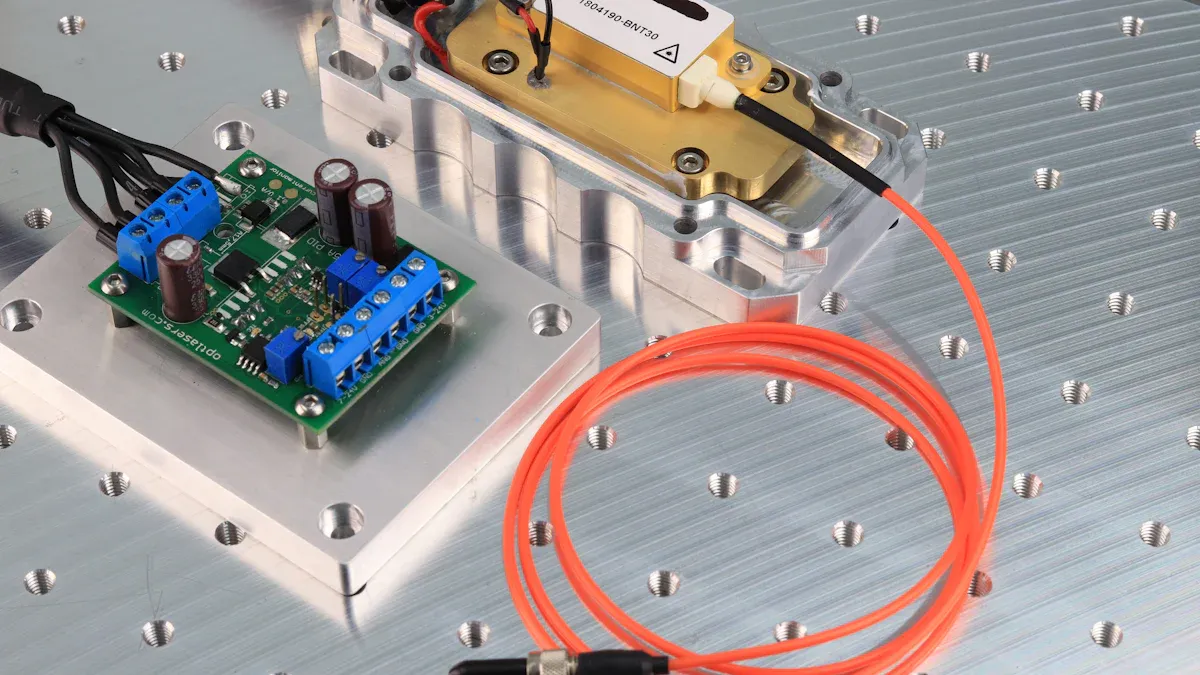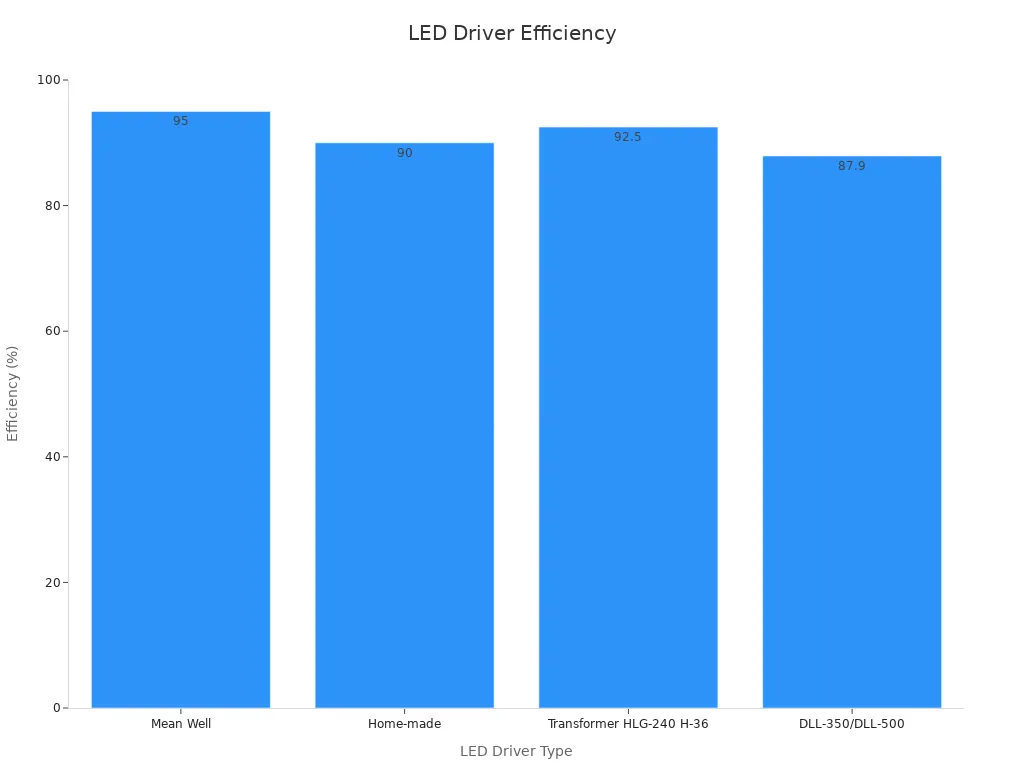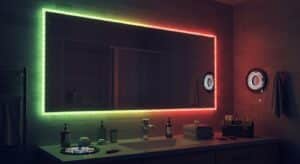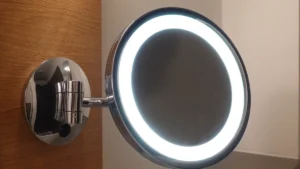
LED driver modules are important parts of modern lights. They control power, helping LEDs work well and last longer. This is even more important with dimmable LED lights becoming popular. Dimming saves energy and cuts electricity bills by up to 20%. Good drivers waste less power, reaching up to 90% efficiency. These improvements show the need for energy-saving ideas in homes, offices, and factories. Comparing popular LED drivers helps you pick the best one for your lights.
Key Takeaways
LED driver modules help control power in LED lights. They make sure the lights work well and last longer.
Picking the right LED driver means looking at power, dimming, safety, and efficiency to fit your lighting needs.
Meanwell drivers save up to 95% energy, making them great for green lighting.
Inventronics drivers are strong and reliable for tough places, while OSRAM drivers are good at showing true colours.
Philips drivers can handle both constant current and voltage, so they work for many uses.
Understanding LED Driver Modules

What Are LED Driver Modules?
An LED driver module is a key part of LED lights. It works like a ballast used in fluorescent lamps. These modules control the current or voltage sent to LEDs. This keeps them working well and stops damage. There are two main types: constant current and constant voltage. Constant current drivers keep the current steady. Constant voltage drivers give a fixed voltage. The choice depends on how the LEDs are set up and what performance is needed.
LED driver modules have specific features like input/output voltage, dimming, and power output. Some can provide up to 10A. This makes them useful for LED strips or powerful lighting systems.
Why Are LED Driver Modules Essential for Lighting Systems?
LED driver modules are vital for making LED lights last longer. They ensure LEDs get the right power, avoiding overheating or poor performance. Without a good driver, LEDs might flicker, dim unevenly, or stop working too soon.
These modules also allow features like dimming and colour changes. For example, 0-10V dimming lets you adjust brightness easily. DALI and DMX512 systems allow remote control, perfect for advanced lighting setups.
LED driver modules also help save energy. Good drivers reduce power loss and can be up to 90% efficient. This lowers electricity costs and supports eco-friendly energy use.
Key Features to Consider When Choosing an LED Driver Module
When picking an LED driver module, check these important features:
Power Output: Make sure the driver can handle the needed wattage. Some, like the ELG-240-24, can give up to 240W.
Dimming Capabilities: Choose drivers with good dimming options like 8-bit PWM or 0-10V dimming for better brightness control.
Safety Standards: Look at the safety class. Class 1 needs extra protection, but Class 2 is safe to touch.
Environmental Protection: Check the IP rating. IP20 is for indoors, while IP67 and IP68 work outdoors or in wet areas.
Efficiency: Pick drivers with high efficiency to save energy and reduce heat.
By considering these points, you can find a driver that fits your lighting needs and improves performance.
Comparison of Popular LED Driver Modules
Meanwell LED Driver Module
Technical Specifications
Meanwell is a trusted brand for LED drivers. Their modules are efficient and reliable. They can save up to 95% of energy, making them very eco-friendly. These drivers work with constant current or constant voltage setups. They can power small lights or big industrial systems, with outputs from 10W to 600W.
Applications
Meanwell drivers are useful for homes, offices, and factories. They are great for LED strip lights because they work well with dimming systems. Their waterproof designs (IP67-rated) make them ideal for outdoor lighting too.
Advantages
Saves energy while being affordable.
Works with many lighting setups due to wide power range.
Strong build ensures long-lasting performance.
Supports advanced dimming systems like 0-10V and DALI.
Disadvantages
Hard to find in some areas.
Costs more upfront than basic models.

Inventronics LED Driver Module
Technical Specifications
Inventronics drivers are tough and flexible. They work with constant current or constant voltage setups. Their power ranges from 25W to 480W. These drivers handle tough conditions with features like heat control and vibration resistance.
Applications
Inventronics drivers are great for many uses. At home, they work well for decorative lighting. In offices, they handle different loads without problems. Factories use them for steady power, which stops flickering and improves safety.
Advantages
Saves energy and supports green lighting.
Reliable for offices and factories.
Built to last in tough environments.
Easy to set up and maintain.
Disadvantages
Less efficient than Meanwell drivers.
Some models have fewer dimming options.
Application Type | Driver Type | Advantages |
|---|---|---|
Residential | Constant Voltage | Easy to install, great for decorative lighting. |
Commercial | Constant Voltage | Energy-saving, handles different loads without issues. |
Industrial | Constant Current | Steady power prevents flickering, improves safety and work quality. |
Automotive | Constant Current | Reliable and long-lasting for advanced car lighting systems. |
Harsh Environments | Robust LED Drivers | Strong design resists heat and vibrations. |
OSRAM LED Driver Module
Technical Specifications
OSRAM drivers are known for bright and accurate lighting. They work with constant current setups and offer power from 20W to 400W. These drivers are perfect for places needing precise colours and high brightness.
Applications
OSRAM drivers are used in shops and galleries where colours must look correct. They also work well for outdoor and building lighting because of their strong designs and IP ratings.
Advantages
Shows colours clearly with high CRI.
Advanced dimming options like DALI and DMX512.
Works well indoors and outdoors.
Saves energy and lowers costs.
Disadvantages
Costs more than other brands.
Few constant voltage models available.
Philips LED Driver Module
Technical Specifications
Philips LED drivers are known for being reliable and efficient. They work with both constant current and constant voltage setups. This makes them useful for many types of lighting systems. Their power ranges from 10W to 400W. They can handle small home lights or big industrial systems. These drivers keep brightness steady and perform well, even in tough conditions.
A 160-W Philips driver prototype showed efficiency as high as 93%. Some stages connected in a series reached 95% efficiency. This means they use less energy and are good for eco-friendly lighting.
Applications
Philips LED drivers can be used in many places. At home, they improve LED strip lights and decorative lamps. In shops and offices, they keep brightness steady for displays and workspaces. Factories use them because they are strong and handle high power needs. They also work well for stage lighting and building designs due to advanced dimming features.
Advantages
Energy Efficiency: They save energy with up to 95% efficiency.
Versatility: They work with constant current and constant voltage setups.
Durability: Built to last in tough conditions.
Advanced Features: Dimming options like 0-10V and DALI give better control.
Eco-Friendly: High efficiency helps reduce energy waste.
Disadvantages
Higher Cost: They cost more than some other brands.
Limited Availability: Some models are hard to find in certain areas.
Tip: If you want energy-saving and high-quality lights, Philips drivers are worth the extra cost.
Comparison Table of Key Features

Summary of Technical Specifications
LED driver modules have different strengths based on their features. Meanwell drivers save lots of energy, reaching up to 95% efficiency. This makes them great for eco-friendly lighting systems. Inventronics drivers are tough and handle heat and vibrations well. They work reliably in hard conditions. OSRAM drivers are best for bright and accurate colours, thanks to their high CRI values. Philips drivers are flexible and support both constant current and constant voltage setups. They also have advanced dimming options.
Feature | Meanwell | Inventronics | OSRAM | Philips |
|---|---|---|---|---|
Efficiency | Up to 95% | Moderate | High | Up to 95% |
Power Range | 10W–600W | 25W–480W | 20W–400W | 10W–400W |
Dimming Options | 0-10V, DALI | Limited | DALI, DMX512 | 0-10V, DALI |
Build Quality | Durable | Robust | Strong | Durable |
Colour Accuracy | Moderate | Moderate | High | High |
Summary of Applications
LED driver modules are used for many types of lighting. Meanwell drivers work well for LED strip lights and outdoor setups because they are waterproof. Inventronics drivers are great for factories and offices. They give steady power that stops flickering. OSRAM drivers are perfect for shops and galleries where colours need to look right. Philips drivers fit many places, like homes, shops, and stages, due to their dimming features.
Application Type | Description |
|---|---|
Residential Lighting | Improves LED strip lights and decorative lamps. |
Commercial Lighting | Powers signs, emergency lights, and car interior lights. |
Retail Systems | Gives accurate colours for shops and galleries. |
Industrial Lighting | Provides steady brightness for factories and workspaces. |
Advanced Lighting Solutions | Works for special setups like adaptive beam applications. |
Summary of Pros and Cons
Each LED driver brand has good points and drawbacks. Meanwell drivers save energy and work with many systems but cost more upfront. Inventronics drivers are strong and save energy but lack advanced dimming options. OSRAM drivers give great colour accuracy and save energy but have fewer constant voltage models. Philips drivers are flexible and eco-friendly but are more expensive than others.
Meanwell Pros:
Saves lots of energy.
Works with many lighting systems.
Strong and waterproof designs.
Meanwell Cons:
Costs more at first.
Hard to find in some places.
Inventronics Pros:
Tough design for hard conditions.
Reliable for offices and factories.
Inventronics Cons:
Few dimming options.
Less efficient than others.
OSRAM Pros:
Great for bright and accurate colours.
Advanced dimming features like DMX512.
OSRAM Cons:
Costs more than others.
Few constant voltage models.
Philips Pros:
Works in many places.
Saves energy with up to 95% efficiency.
Philips Cons:
Costs more than other brands.
Some models are hard to find.
Tip: Choose OSRAM drivers for accurate colours. For saving energy, pick Philips or Meanwell drivers.
Choosing the Right LED Driver Module for Your Lighting Needs
Residential Lighting
For home lighting, pick drivers that save energy and fit your lights. Common home lights include LED strips, decorative lamps, and mood lighting. These need drivers that dim well and keep brightness steady. For example, 0-10V dimming drivers let you change brightness for different tasks or moods.
Think about how bright and efficient your lights are. The DesignLights Consortium (DLC) says indoor premium lights should reach 140 lm/W. LED modules should hit 180 lm/W for good brightness and energy savings. Also, check for flicker-free lighting. Standards like Pst ≤ 1 and SVM ≤ 0.9 ensure safe and comfy lighting.
Durability is also important. Look for L70, L80, or L90 ratings. These show how long LEDs stay bright. For instance, an L90/B10 rating means 90% of LEDs keep 90% brightness after many hours. This ensures your lights last a long time.
Tip: Pick drivers with great efficiency and dimming to make your home lighting better and save energy.
Commercial Lighting
In offices or shops, drivers must handle many uses like displays and emergency lights. Choose drivers that work steadily and have features like DALI or DMX512 dimming. These let you control brightness and colours remotely, perfect for shops or galleries.
Compare drivers from different brands. Their performance can differ due to filters and parts like ferrites. To reduce electromagnetic interference (EMI), turn off PWM when possible. Use AC filters and keep cables apart to improve reliability.
Parts like capacitors and MOSFETs wear out over time. This affects how long drivers last. Knowing these factors helps you plan your lighting system’s lifespan. Studies show real-world use and conditions greatly impact driver durability.
Note: For offices or shops, pick drivers with strong designs and advanced controls for steady and flexible lighting.
Industrial Lighting
Factories and warehouses need tough drivers that work well in hard conditions. These places often use drivers with strong builds, high power, and good heat control. Constant current drivers stop flickering and keep workers safe.
The industrial LED driver market is growing fast. By 2030, it may reach US$98.1 billion. This shows the need for reliable, energy-saving lights in factories. Efficient drivers, some up to 95%, cut energy use and costs.
Metric | Value |
|---|---|
Market Value in 2024 | US$31.3 Billion |
Projected Market Value by 2030 | US$98.1 Billion |
CAGR (2024-2030) | 21.0% |
Focus of Report | Performance and longevity data |
For outdoor or wet areas, pick drivers with IP67 or IP68 ratings. These are durable and safe. Advanced dimming, like DALI, makes industrial lighting more flexible.
Tip: For factories or warehouses, choose drivers that are efficient, tough, and full of features to handle tough jobs.
Specialised Applications
LED driver modules are key for unique lighting needs. These setups often need exact control, high efficiency, and strong performance. They are used where regular lights do not work well. Below are examples of how LED drivers shine in special situations.
1. Stage and Event Lighting
Stage lighting needs changing brightness and colours. LED drivers with dimming features like DMX512 help create cool effects. They make colour changes smooth and brightness steady. For concerts or plays, LED strip lights can highlight stage parts or make colourful backdrops. These drivers work well even with heavy use, keeping the show running smoothly.
2. Automotive Lighting
Cars use LED lights for headlights, taillights, and inside lighting. Automotive LED drivers handle vibrations, heat, and moisture. They give steady brightness for safety and style. Good drivers make headlights bright for clear vision and inside lights cosy. Some advanced ones adjust light patterns based on driving needs.
3. Medical and Laboratory Lighting
Hospitals and labs need lights with true colours and steady brightness. LED drivers with high CRI make colours look real, which is important for surgeries or tests. Some drivers are made for UV LEDs used in cleaning or curing. These drivers give exact control for reliable results.
4. Horticultural Lighting
In farming, plants need certain light to grow. LED drivers power lights that copy sunlight, helping plants grow better. You can change the light’s strength and type for different growth stages. Waterproof drivers with IP67 ratings are great for greenhouses as they handle wet conditions.
5. Architectural and Decorative Lighting
Architectural lighting shows off building designs, while decorative lighting adds beauty. LED drivers with dimming and colour-changing features are perfect for this. They light up bridges, monuments, or walls with cool patterns. Indoors, they power LED strips for cosy or fancy looks. These drivers keep lights bright and lasting long.
6. Emergency and Safety Lighting
Emergency lights need reliable LED drivers. They power exit signs, pathway lights, and backup lights during blackouts. These drivers must work perfectly in emergencies. Some have battery backups to keep lights on. Others have self-check features to ensure they are always ready.
Tip: When picking an LED driver for special uses, think about the environment, needed brightness, and control options. This helps ensure the best performance and long life.
Picking the right LED driver module is very important. It helps your LEDs work well, last longer, and stay bright. Each brand has its own strengths. Meanwell saves energy, Inventronics is tough for hard conditions, OSRAM gives great colour accuracy, and Philips is flexible with advanced dimming.
Think about what you need before choosing. For homes, pick energy-saving drivers with dimming. In offices or shops, choose drivers with smart controls like DALI. For factories, go for strong drivers with high power and heat control.
Feature | Benefit |
|---|---|
Steady current control | Helps LEDs last longer and shine brighter |
Adjustable dimming | Lets you save energy by changing brightness |
Smart system connection | Allows remote control for easier use |
Small size | Fits into different setups without losing performance |
Knowing the difference between constant current and constant voltage drivers is key. Check your LED type, power needs, and space for setup. This helps you pick a driver that matches your goals, like saving energy, cutting costs, or adding advanced features.
Tip: Match the driver to the job. Use constant current drivers for factories and constant voltage drivers for decorative lights.
FAQ
What is the difference between constant current and constant voltage LED drivers?
Constant current drivers keep the current steady. They work well for LEDs in series. Constant voltage drivers give a fixed voltage. They are good for LEDs in parallel. Choose based on your lighting setup.
How do I choose the right LED driver for outdoor lighting?
Pick drivers with high IP ratings like IP67 or IP68. These protect against water and dust. Strong designs and efficient power use make them last longer outside.
Can LED drivers improve energy efficiency?
Yes, LED drivers deliver power efficiently to reduce waste. Some drivers save up to 95% of energy. This lowers electricity bills and helps the environment.
Are dimming features necessary for residential lighting?
Dimming makes home lighting more flexible. You can change brightness for tasks or moods. Drivers with 0-10V or DALI dimming give smooth control.
How long do LED drivers typically last?
LED drivers last 30,000 to 50,000 hours. Quality and good heat control help them last longer. Durable drivers keep your lights working well.
See Also
Selecting The Perfect LED Light Module For Your Needs
Comparing SMD 2835, 5050, And 3528 LED Strips
Improving Sign Board Illumination With LED Modules
Evaluating High-Brightness LED Strips For Various Uses
Exploring RGB LED Modules And Their 2025 Applications



